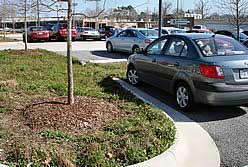Science Wednesday: Science is Cool
Wednesday, June 17th, 2009 Each week we write about the science behind environmental protection. Previous Science Wednesdays.
Each week we write about the science behind environmental protection. Previous Science Wednesdays.
Imagine powering your computer using an energy cell fueled by cow manure. Or using gold dust as the key ingredient in a glamorous yet inexpensive sunscreen?
These products aren’t so far away, and the minds behind these amazing ideas are students between 14-18 years old. Over 1,500 high school students met in Reno, NV last month to showcase their independent research at the world’s premiere pre-collegiate science competition – the Intel International Science and Engineering Fair.
Forget about the blue ribbon and $20 gift certificate for the homemade volcano. These kids were bringing some serious science: biochemistry, electrical and mechanical engineering, environmental management, nuclear and particle physics, cellular and molecular biology, and medicine and health sciences—just to name a few.
Because it looked like such an amazing opportunity for EPA’s Year of Science 2009, activities, I wrote a proposal that would include EPA in the 2009 ISEF as a Special Awards presenter. EPA’s award included an all-expense-paid trip to Washington, D.C. to attend the P3: People, Planet and Prosperity Student Design Competition for Sustainability and display their project on the national mall.
High school sophomore Ryan Alexander was the winner of EPA’s 2009 Sustainability Award with his outstanding project, Gone with the Windmills: An Analysis of the Effectiveness of an Oscillating Wind Energy Generator. Our judges were blown away with this guy (okay, pun intended). Not only was he brilliant (he is skipping the next 2 years of high school to attend college) but he was a poised, charismatic salesman. Ryan was pitching his project with the prowess of a seasoned CEO. We joked about buying stock in his future company.
The best part of my experience at the competition was interacting with the students. After all, they were just kids, but to hear their casual conversations was inspiring. They joked about algorithms and played anagram games. Here, the quintessential nerd did not exist. There were no classifications, just regular people who felt that science and knowledge was the status quo. It reminded me of something I felt at a much less prestigious science fair I participated in many years ago. You can’t let anyone tell you that science is just for people who wear dorky glasses and study quantum physics all the time. Science allows you to appreciate more about the world. By learning and studying it, you can understand anything from how to program a video game to how wormholes might connect possible alternate universes. It even energizes people about manure. How can you say that is not cool?!
About the author: Patrick Hurd has been joined EPA in September, 2008 and is an intern in the S.T.E.P. program. He has a background in marine biology and is currently working with the Science Communications Staff in the Office of Research and Development.


 I recently got my chance to look at the latest Energy Star refrigerators. In addition to Side-by-Side refrigerators, there are the French door refrigerators. These refrigerators have two doors on the top and a bottom freezer, making them extremely energy efficient. The more energy efficient refrigerator should result in a savings $4.00 or $5.00 a month on my utility bill. For more information on Energy Star appliances, see
I recently got my chance to look at the latest Energy Star refrigerators. In addition to Side-by-Side refrigerators, there are the French door refrigerators. These refrigerators have two doors on the top and a bottom freezer, making them extremely energy efficient. The more energy efficient refrigerator should result in a savings $4.00 or $5.00 a month on my utility bill. For more information on Energy Star appliances, see  Another program within EPA is the Office of Solid Waste and Emergency Response Innovative Pilots, which funded several projects that tested new or underused ideas in environmental protection. One pilot was called “Creating an Integrated “Green” Parking Lot and Urban Wetlands on a Former Commercial Site.”
Another program within EPA is the Office of Solid Waste and Emergency Response Innovative Pilots, which funded several projects that tested new or underused ideas in environmental protection. One pilot was called “Creating an Integrated “Green” Parking Lot and Urban Wetlands on a Former Commercial Site.” This pilot occurred at the Heifer International Headquarters in Little Rock, Arkansas. Heifer International constructed a wetland ecosystem and integrated its parking lot into it. Small green parking areas were designed to collect, cleanse, and recycle storm water into the environment. This project was so successful that EPA prepared
This pilot occurred at the Heifer International Headquarters in Little Rock, Arkansas. Heifer International constructed a wetland ecosystem and integrated its parking lot into it. Small green parking areas were designed to collect, cleanse, and recycle storm water into the environment. This project was so successful that EPA prepared